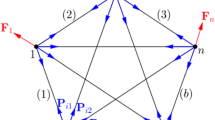Abstract
In this work, we investigate a combination of classical optimization techniques from optimal control and a rounding strategy based on shape optimization for interface identification for problems constrained by partial differential equations. The goal is to identify the location of pollution sources in a fluid flow represented by a control that is either active or inactive. We use a relaxation of the binary problem on a coarse grid as initial guess for the shape optimization with higher resolution. The result is a computationally cheap method, where large shape deformations do not have to be performed. We demonstrate that our algorithm is, moreover, able to change the topology of the initial guess.














Similar content being viewed by others
References
Cheney, M., Isaacson, D., Newell, J.: Electrical impedance tomography. SIAM Rev. 41(1), 85–101 (1999)
Hintermüller, M., Laurain, A.: Electrical impedance tomography: from topology to shape. Control Cybern. 37(4), 913–933 (2008)
Allaire, G., Jouve, F., Toader, A.: Structural optimization using sensitivity analysis and a level-set method. J. Comput. Phys. 194(1), 363–393 (2004)
Schmidt, S., Wadbro, E., Berggren, M.: Large-scale three-dimensional acoustic horn optimization. SIAM J. Sci. Comput. 38(6), B917–B940 (2016)
Mohammadi, B., Pironneau, O.: Applied Shape Optimization for Fluids. Oxford University Press, Oxford (2001)
Jameson, A.: Aerodynamic Shape Optimization Using the Adjoint Method. Lectures at the Von Karman Institute, Brussels (2003)
Giles, M.B., Pierce, N.A.: An introduction to the adjoint approach to design. Flow Turbul. Combust. 65(3–4), 393–415 (2000)
Allaire, G.: Shape Optimization by the Homogenization Method, vol. 146. Springer, Berlin (2012)
Gangl, P., Langer, U., Laurain, A., Meftahi, H., Sturm, K.: Shape optimization of an electric motor subject to nonlinear magnetostatics. SIAM J. Sci. Comput. 37(6), B1002–B1025 (2015)
Schulz, V., Siebenborn, M.: Computational comparison of surface metrics for PDE constrained shape optimization. Comput. Methods Appl. Math. 16, 485–496 (2016). https://doi.org/10.1515/cmam-2016-0009
Schulz, V., Siebenborn, M., Welker, K.: Efficient PDE constrained shape optimization based on Steklov–Poincaré-type metrics. SIAM J. Optim. 26(4), 2800–2819 (2016). https://doi.org/10.1137/15M1029369
Laurain, A., Sturm, K.: Distributed shape derivative via averaged adjoint method and applications. ESAIM Math. Model. Numer. Anal. 50(4), 1241–1267 (2016). https://doi.org/10.1051/m2an/2015075
Hante, F.M., Sager, S.: Relaxation methods for mixed-integer optimal control of partial differential equations. Comput. Optim. Appl. 55(1), 197–225 (2013). https://doi.org/10.1007/s10589-012-9518-3
Tröltzsch, F.: Optimal Control of Partial Differential Equations. Graduate Studies in Mathematics. American Mathematical Society, Providence, RI (2010). https://doi.org/10.1090/gsm/112
Hintermüller, M., Ito, K., Kunisch, K.: The primal–dual active set strategy as a semismooth Newton method. SIAM J. Optim. 13(3), 865–888 (2002)
Weiser, M., Gänzler, T., Schiela, A.: A control reduced primal interior point method for a class of control constrained optimal control problems. Comput. Optim. Appl. 41(1), 127–145 (2008). https://doi.org/10.1007/s10589-007-9088-y
Ulbrich, M.: Semismooth Newton methods for operator equations in function spaces. SIAM J. Optim. 13(3), 805–841 (2002)
Herzog, R., Kunisch, K.: Algorithms for PDE-constrained optimization. GAMM-Mitteilungen 33(2), 163–176 (2010)
Bergounioux, M., Kunisch, K.: Augmented Lagrangian techniques for elliptic state constrained optimal control problems. SIAM J. Control Optim. 35(5), 1524–1543 (1997)
Sokolowski, J., Zolesio, J.-P.: Introduction to Shape Optimization. Springer Series in Computational Mathematics, vol. 16, pp. 5–12. Springer, Berlin, Heidelberg (1992)
Delfour, M., Zolésio, J.P.: Shapes and Geometries: Metrics, Analysis, Differential Calculus, and Optimization. Advances in Design and Control, vol. 22, 2nd edn. SIAM, Philadelphia (2001)
Correa, R., Seeger, A.: Directional derivative of a minmax function. Nonlinear Anal. Theory Methods Appl. 9(1), 13–22 (1985)
Haslinger, J., Mäkinen, R.: Introduction to Shape Optimization: Theory, Approximation, and Computation. Advances in Design and Control, vol. 7. SIAM, Philadelphia (2003)
Welker, K.: Efficient PDE constrained shape optimization in shape spaces. Ph.D. Thesis, Universität Trier (2016)
Evans, L.: Partial Differential Equations. American Mathematical Society, Providence (1993)
Nittka, R.: Regularity of solutions of linear second order elliptic and parabolic boundary value problems on Lipschitz domains. J. Differ. Equ. 251(4–5), 860–880 (2011)
Moës, N., Dolbow, J., Belytschko, T.: A finite element method for crack growth without remeshing. Int. J. Numer. Methods Eng. 46(1), 131–150 (1999)
Geuzaine, C., Remacle, J.F.: Gmsh: a 3-d finite element mesh generator with built-in pre-and post-processing facilities. Int. J. Numer. Methods Eng. 79(11), 1309–1331 (2009)
Acknowledgements
This work has been partly supported by the German Research Foundation (DFG) within the priority program SPP 1648 “Software for Exascale Computing” under Contract No. Schu804/12-1 and the research training group 2126 “Algorithmic Optimization.”
Author information
Authors and Affiliations
Corresponding author
Additional information
Communicated by Zenon Mróz.
Rights and permissions
About this article
Cite this article
Siebenborn, M. A Shape Optimization Algorithm for Interface Identification Allowing Topological Changes. J Optim Theory Appl 177, 306–328 (2018). https://doi.org/10.1007/s10957-018-1279-4
Received:
Accepted:
Published:
Issue Date:
DOI: https://doi.org/10.1007/s10957-018-1279-4




